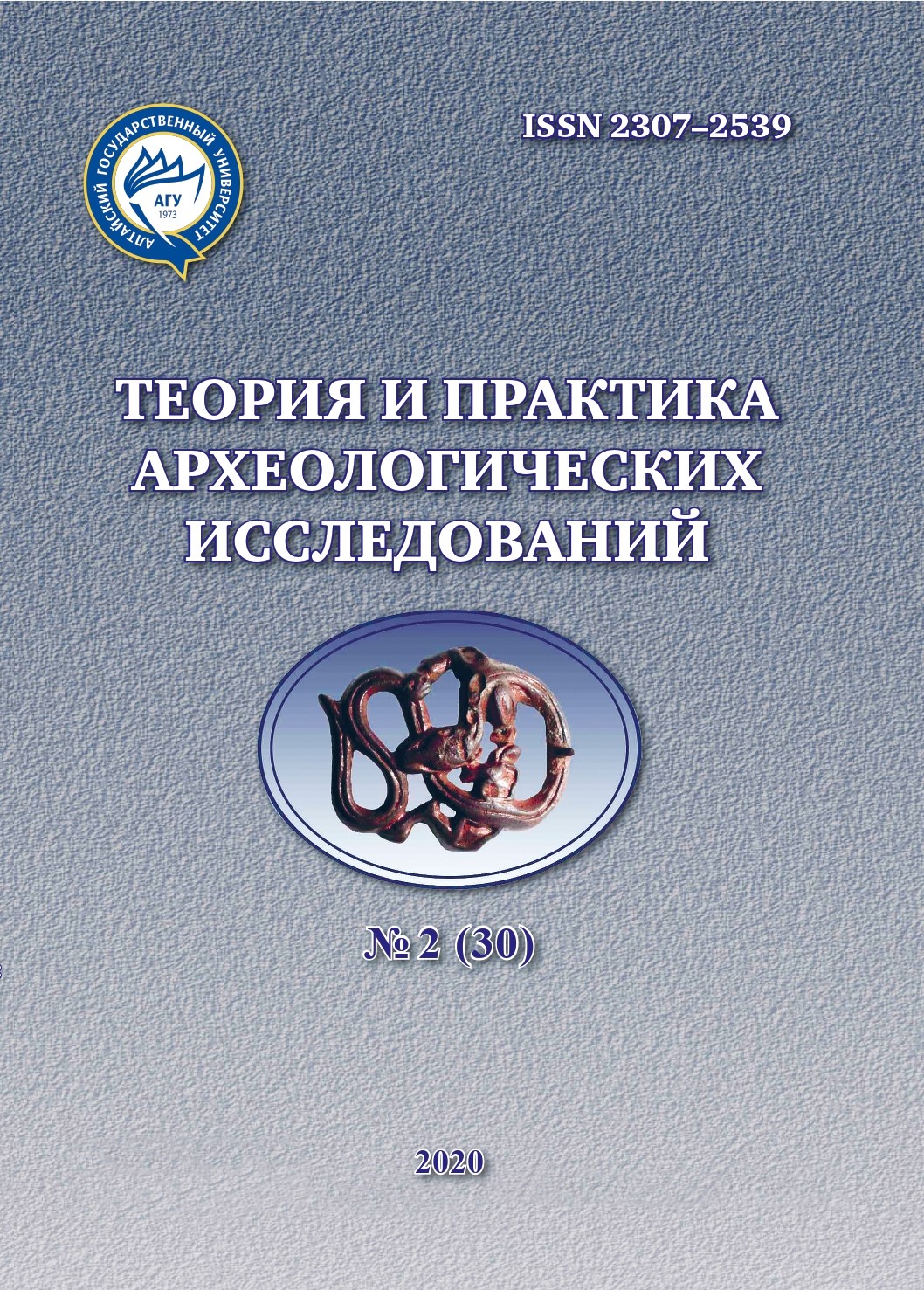ИЗНАЧАЛЬНЫЙ ДЗЁМОН, ЯПОНСКИЙ АРХИПЕЛАГ: ХРОНОЛОГИЯ И НЕКОТОРЫЕ ОСОБЕННОСТИ КАМЕННОГО ИНВЕНТАРЯ
Аннотация
Дзёмон – эпоха неолита на островах Японского архипелага. Она датируется временем 13 800–2400 л.н. и подразделяется на шесть периодов. В рамках первого периода – изначального дзёмона (13 800–10 000 л.н.) наряду с появлением древнейшей керамической посуды происходит и существенное изменение каменного инвентаря, исчезают палеолитические техники расщепления (пластинчатая и микропластинчатая), наблюдается эволюция бифасиальных наконечников, совершенствуются орудия дистанционной охоты, начинается систематическое использование лука и стрел, появляется широкая линейка рубящих орудий, включая инструменты с подшлифовкой рабочего лезвия. Вместе с этим прослеживаются и заметные локальные различия в орудийном наборе и динамике его трансформации в северной и южной, внутренней и прибрежной частях архипелага. Экспериментальные исследования позволяют выяснить особенности различных техник обработки, необходимые трудозатраты при изготовлении рубящих орудий и эффективность использования. К концу рассматриваемого периода (около 10 тыс. л.н.) каменный инструментарий приобретает черты, свойственные всей дальнейшей эпохе дзёмон.
Скачивания
Metrics
Литература
Okladnikov A.P. Neoliticheskie pamyatniki kak istochniki po etnogonii Sibiri i Dal’nego Vostoka [Neolithic Sites as Sources on the Ethnogony of Siberia and Far East]. Kratkie soobshcheniya Instituta istorii material’noj kul’tury [Brief Messages of the Institute of Material Culture]. 1941. Vyp. IX. Pp. 5–14.
Okladnikov A.P. K voprosu o drevnejshem naselenii Yaponskih ostrovov i ego kul’ture [Towards the Question of the Earliest People of the Japanese Islands and Their Culture]. Sovetskaya etnografiya [Soviet Ethnography]. 1946. №4. Pp. 11–33.
Tabarev A.V. Dal’nevostochnaya al’ternativa (eshche raz o putyah i vremeni pervonachal’nogo zaseleniya amerikanskogo kontinenta) [Fareastern Alternative (One more time about the routes and time of the initial peopling of the American continent)]. Rossijskij arheologicheskij ezhegodnik [Russian Archaeological Yearbook]. 2012. №2. Pp. 103–147, 169–171.
Tabarev A.V., Ivanova D.A. Pogrebeniya, keramika, rakovinnye kuchi: iz istorii izucheniya pamyatnikov epohi Dzyomon, Yaponskij arhipelag [Burials, Pottery, Shell Mounds: from the History of the Tesearch of Jomon Epoch Sites, Japanese Archipelago]. Gumanitarnye issledovaniya v Vostochnoj Sibiri i na Dal’nem Vostoke [Humanities in Eastern Siberia and Far East]. 2018. №2. Pp. 36–42.
Beginning of the Jomon Culture. What Took Place in 15,000 Years Ago? Tokyo: National Museum of Japanese History, 2009. 187 p. (In Japanese).
Gibbs K., Jordan P. A Сomparative Perspective on the ‘Western’ and ‘Eastern’ Neolithics of Eurasia: Ceramics, Agriculture and Sedentism // Quaternary International. 2016. V. 419. Pp. 27–35.
Hinata Caves. Archaeological Research on the Incipient and Initial Jomon Period. Yamagata: Tohoku University of Art and Design, 2019. (In Japanese with English Summary). Ikawa F. The Continuity of Non-Ceramic to Ceramic Cultures in Japan // Arctic Anthropology. 1964. V. 2. Pp. 95–119.
Kaner S., Taniguchi Y. The Development of Pottery and Associated Technological Developments in Japan, Korea, and the Russian Far East // Handbook of East and Southeast Asian Archaeology. New York : Springer, 2017. Pp. 321–345.
Keally C.T., Taniguchi Y., Kuzmin Y.V. Understanding the Beginnings of Pottery Technology in Japan and Neighboring East Asia // The Review of Archaeology. 2003. V. 24. P. 3–14.
Lithic Assemblage from Western Terrace of Hinata Cave. V. I: Spear Points Workshop in the Incipient Jomon. Sendai : Tohoku Gakuin University, 2006. 136 p. (In Japanese with English Summary) Morisaki K., Natsuki D. Human Behavioral Change and the Distributional Dynamics of Early Japanese Pottery // Quaternary International. 2017. V. 441. P. 91–101.
Mikoshiba Site. Excavation and Research at a Site Transitional from the Terminal Late Paleolithic to the Incipient Jomon Period. Shimaki Shoseki Publishing Center, 2008. (In Japanese with English Summary). Miyazaki H., Keally C.T. A Terminal Pleistocene Salmon-Fishing and Lithic Worksite at Maeda Kochi, Tokyo, Japan // Current Research in the Pleistocene. 1986. V. 3. P. 96–97.
Morisaki K., Oda N., Kunikita D., Sasaki Y. Sedentism, Pottery and Inland Fishing in Late Glacial Japan: a Reassessment of the Maedakochi Site // Antiquity. 2019. V. 93. Pp. 1442–1459.
Morse E. Traces of Early Man in Japan // Nature. 1877. V. 17. P. 89.
Nanatsuguri Site. Excavation of a Late Palaeolithic and Early Jomon Site. Shinano-machi Board of Education, 2008. 72 p. (In Japanese with English Summary). Odai-Yamamoto I Site Excavation Team. Archaeological Research at the Odai Yamamoto I Site. Tokyo: Odai-Yamamoto I Site Excavation Team, 1999. 114 p. (In Japanese).
Omoto K., Takeishi K., Nishida S., Fukui J. Calibrated 14C Ages of Jomon Sites, NE Japan, and Their Significance // Radiocarbon. 2010. V. 52, №2–3. Pp. 534–546.
Sato H., Natsuki D. Human Behavioral Responses to Environmental Conditions and the Emergence of the World’s Oldest Pottery in East and Northeast Asia: an Overview // Quaternary International. 2017. V. 441(B). Pp. 12–28.
Shimamuro O., Toya K., Tanaka K., Nakamura Y., Mochizuki A., Tsutsumi T. Kokajihara site Karasawa B Site: Transitional Lithic Industries of the Terminal Upper Palaeolithic to the Incipient Jomon // Archeological Monographs. Shimae Shoseki Publishing Center, 2009. 69 p. (In Japanese with English Summary)
Sugihara S. Radiocarbon Dating on Archaeological Materials from Natsushima Shell Mound in Kanagawa Prefecture // Sundaishigaku. 1962. V. 12. Pp. 119–22. (In Japanese)
Tsutsumi T. Origins of Pottery and Human Strategies for Adaptation During the Termination of the Last-Glacial Period in the Japanese Archipelago // The Origins of Pottery and Agriculture. Kyoto : International Research Center for Japanese Studies, 2002. Pp. 241–262.
Tsutsumi T. MIS3 Edge-ground Axes and the Arrival of the first Homo sapiens in the Japanese Archipelago // Quaternary International. 2012. V. 248. Рp. 70–78.
Yamanuochi S. Classification and Subclassification of Jomon Pottery // Prehistoric Archaeology. 1937. V. 1. Pp. 28–32. (In Japanese)
Yanshina O. V. The Earliest Pottery of the Eastern Part of Asia: Similarities and differences. Quaternary International. 2017. V. 441. Pp. 69–80.
Авторы, публикующиеся в данном журнале, соглашаются со следующими условиями:
a. Авторы сохраняют за собой права на авторство своей работы и предоставляют журналу право первой публикации этой работы с правом после публикации распространять работу на условиях лицензии Creative Commons Attribution License, которая позволяет другим лицам свободно распространять опубликованную работу с обязательной ссылокой на авторов оригинальной работы и оригинальную публикацию в этом журнале.
b. Авторы сохраняют право заключать отдельные договора на неэксклюзивное распространение работы в том виде, в котором она была опубликована этим журналом (например, размещать работу в электронном архиве учреждения или публиковать в составе монографии), с условием сохраниения ссылки на оригинальную публикацию в этом журнале. с. Политика журнала разрешает и поощряет размещение авторами в сети Интернет (например в институтском хранилище или на персональном сайте) рукописи работы как до ее подачи в редакцию, так и во время ее редакционной обработки, так как это способствует продуктивной научной дискуссии и положительно сказывается на оперативности и динамике цитирования статьи








2.jpg)



